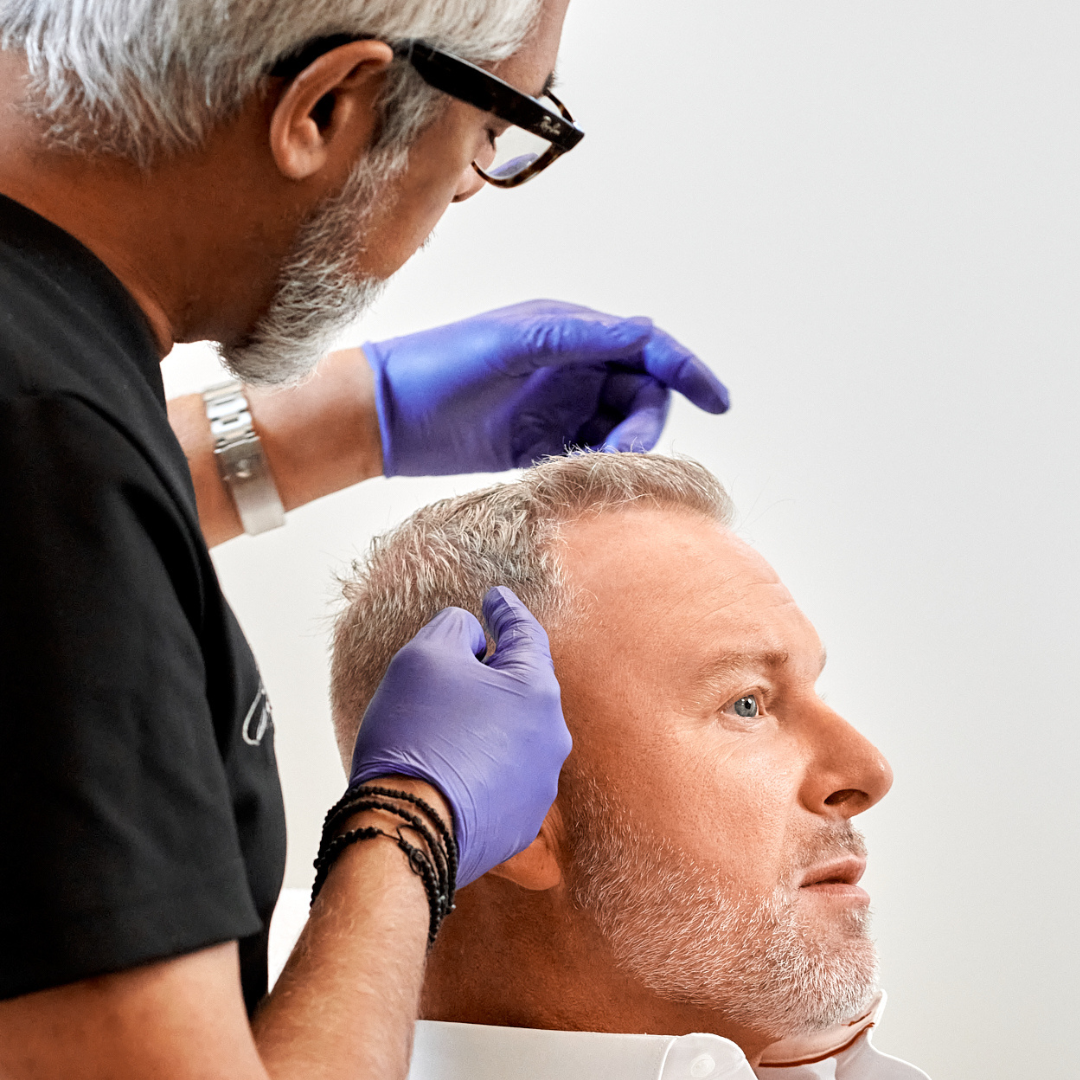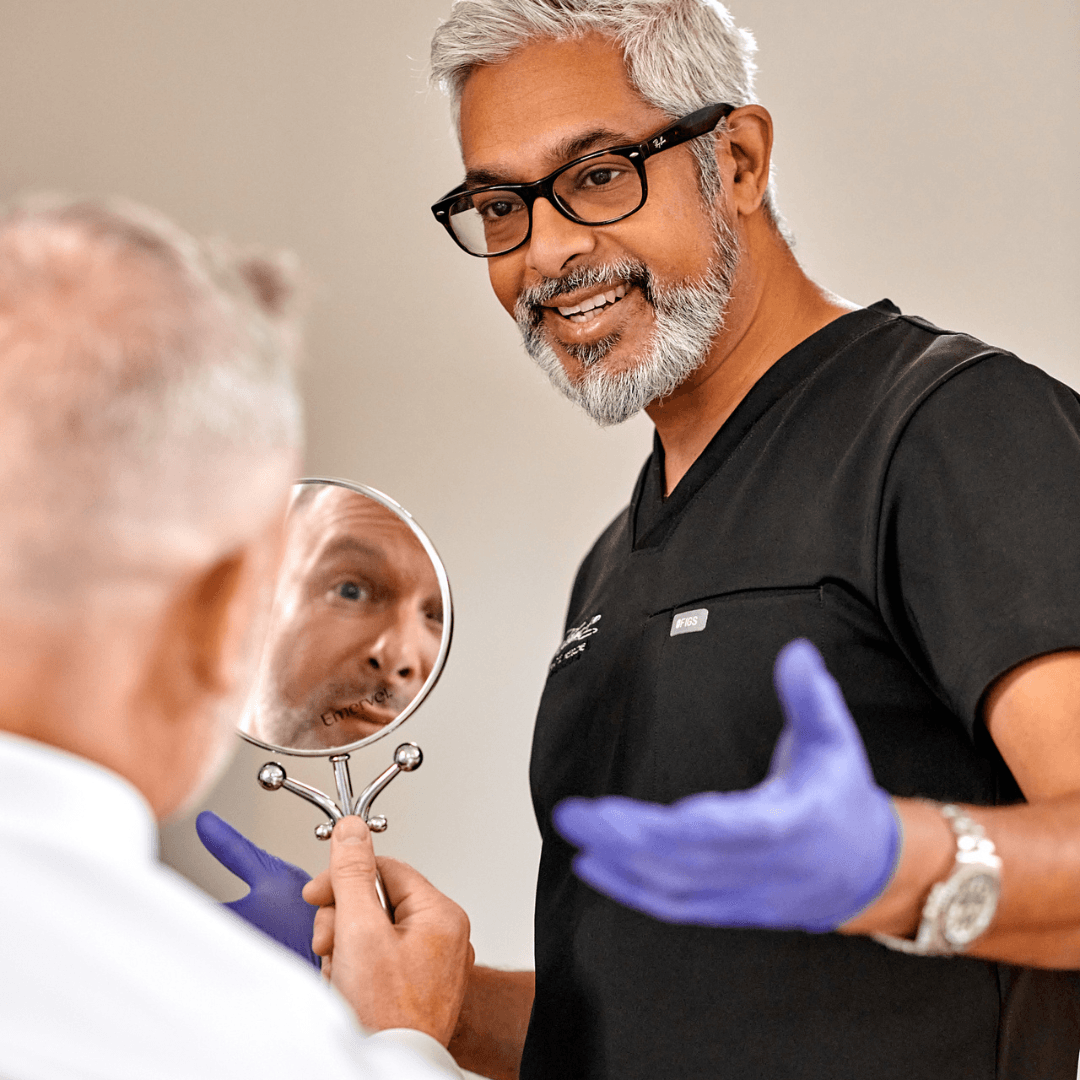All about Alopecia: Causes, Symptoms and Treatment Solutions
According to Medichair statistics, around 85% of men and 33% of women will experience alopecia at some point. Androgenetic alopecia is the most common type, affecting around 95% of people with alopecia. Women are more likely to report being affected by hair loss, with 84% reporting it, but only 2% of women are affected by baldness.
According to the Canadian Dermatology Association, we lose about 50 to 100 hairs a day, and others normally grow in to replace them. When you lose more hair than grows back, it may be a sign of alopecia.
The unique Clinique M approach
At Clinique M, we provide advanced medical expertise with exclusive bio-regenerative treatments supervised by Dr. Nyan Narine, a specialist in hair restoration. Through innovations such as PRP (Platelet-Rich Plasma), we help our patients stop hair loss, stimulate regrowth, and revitalize the scalp — all without surgery or discomfort. Each protocol is tailored to your specific type of hair loss and your goals, to achieve visible and long-lasting results.
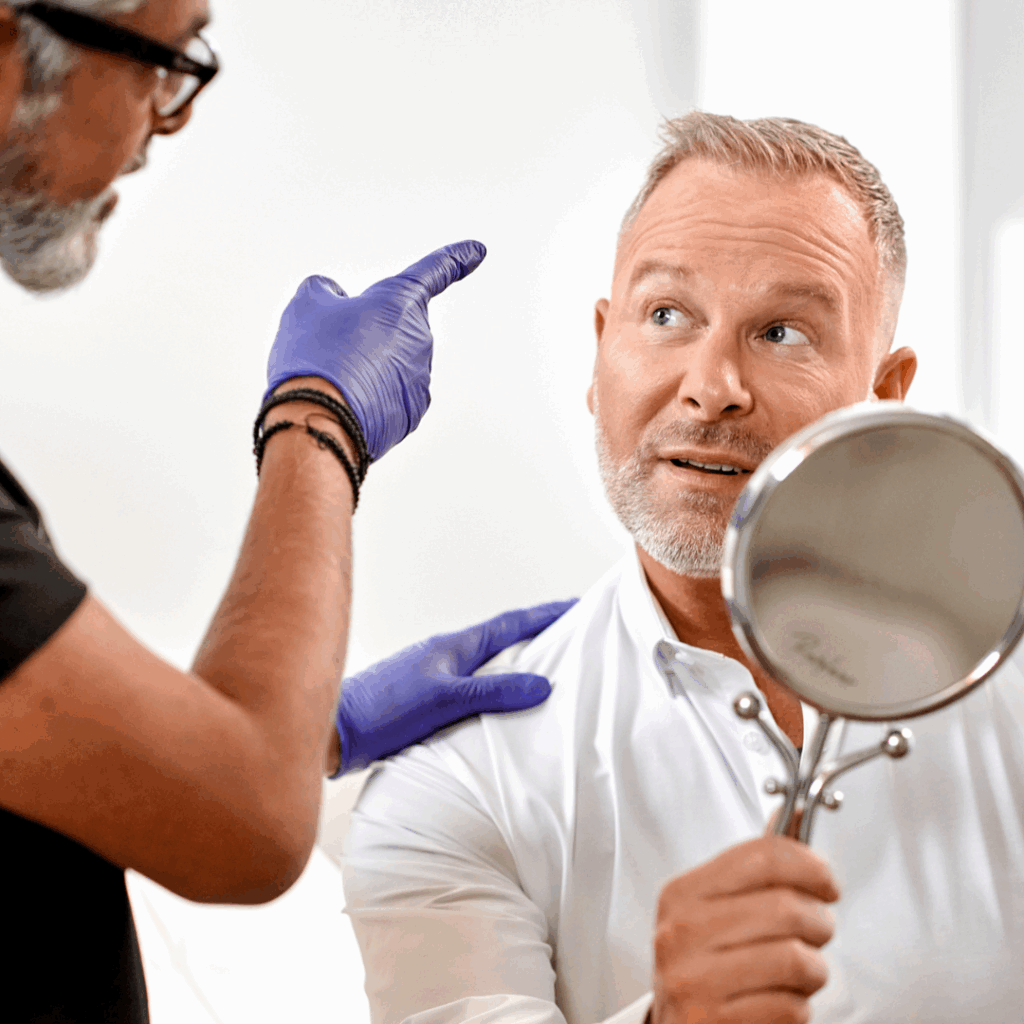
Treatments
What is alopecia?
Alopecia is a common condition characterized by excessive and abnormal hair loss. It can affect both men and women and can be caused by various factors such as hormonal imbalances, genetic predisposition, health problems or environmental factors.
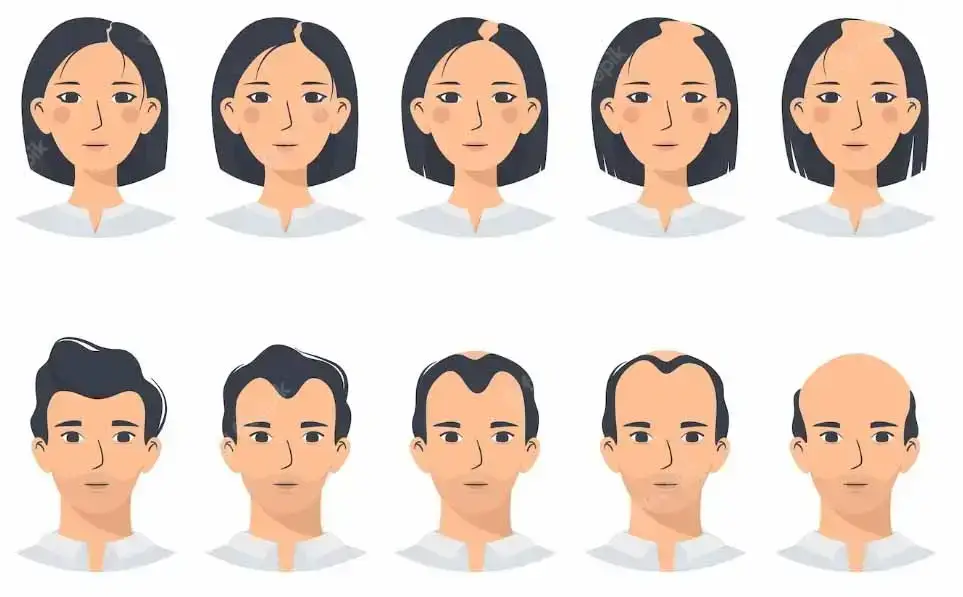
Androgenetic alopecia
Androgenetic alopecia, also known as male pattern baldness, is the most common form of hair loss. Genetic factors and male sex hormones, such as testosterone mainly cause it.
Here are some important things to know about androgenetic alopecia:
Free consultation
Prevalence
Androgenetic alopecia affects both men and women but is more common in men. It is estimated to affect around 50% of men and 20% of women.
Symptoms in men
In men, androgenetic alopecia generally manifests itself as hair loss on the top of the head, leaving a crown of hair around the head. Hair becomes progressively thinner and less pigmented.
Symptoms
In women, androgenetic alopecia is characterized by more diffuse and less pronounced hair loss than in men. It may begin with a widening of the hairline, a reduction in hair volume and a loss of density.
Norwood-Hamilton Scale
There is a scale for measuring androgenetic alopecia and its different stages: the Norwood-Hamilton scale.
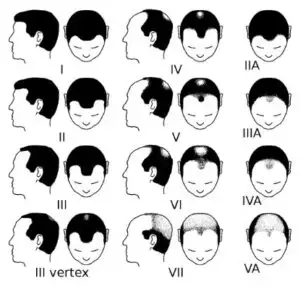
Causes
Androgenetic alopecia is mainly caused by excessive sensitivity of hair follicles to the activity of male hormones called androgens. A specific hormone called dihydrotestosterone (DHT) plays a key role in this process.
Genetic factors
Androgenetic alopecia has a significant genetic component. If members of your family, particularly your parents, have suffered from baldness, you are more likely to develop this condition.
Alopecia areata
Alopecia areata manifests itself as hair loss in the form of circular patches. Alopecia areata is also known as pelada. It causes localized, patchy hair loss. This condition is generally attributed to an autoimmune reaction that attacks the hair follicles.
Free consultation
Causes
Alopecia areata is considered an autoimmune disease, meaning that the immune system mistakenly attacks the hair follicles. The exact causes of this disease are not yet fully understood, but genetic and environmental factors may play a role.
Symptoms
Alopecia areata manifests as patches of round or oval hair loss on the scalp, face or other body parts. Patches may be small or large and may develop rapidly or slowly.
Diagnosis
Diagnosis of alopecia areata is usually based on clinical examination and consideration of medical and family history. In some cases, a scalp biopsy may be required to confirm the diagnosis.
Treatment
There is no cure for alopecia areata, but there are several treatment options to help stimulate hair regrowth and reduce disease progression. Treatment options include corticosteroids, immunotherapies, laser treatments and hair transplants.
Prognosis
The prognosis for alopecia areata varies from person to person. In some cases, hair may grow back spontaneously without treatment, while in others, the disease may progress and lead to further hair loss. People with alopecia areata may also be at risk of developing other autoimmune diseases.
It’s important to note that alopecia areata can have a significant impact on quality of life and self-esteem. If you are concerned about hair loss, it is advisable to consult a dermatologist for an accurate diagnosis and to discuss available treatment options.
Scarring alopecia
Scarring alopecia occurs when hair follicles are destroyed and replaced by scar tissue. Causes can include infections, trauma or skin diseases such as lupus or lichen planopilaris.
Free consultation
Causes
Scarring alopecia is caused by scalp inflammation that damages the hair follicles. The causes of inflammation can be diverse, including infections, autoimmune diseases, burns, trauma or surgery.
Symptoms
Symptoms of scarring alopecia include irreversible hair loss, redness and inflammation of the scalp, pain and itching.
Diagnosis
Diagnosis of scarring alopecia is usually based on clinical examination and consideration of medical and family history. In some cases, a scalp biopsy may be required to confirm the diagnosis.
Treatment
There is no cure for scarring alopecia, as hair follicles are permanently destroyed. However, there are treatment options to help reduce inflammation and prevent disease progression. Treatment options include corticosteroids, immunosuppressants, antibiotics and laser treatments.
Prognosis
The prognosis of scarring alopecia depends on the underlying cause and management speed. In some cases, hair loss may be halted or slowed, while in others, the disease may progress and lead to further hair loss.
It’s important to note that scarring alopecia can have a significant impact on quality of life and self-esteem. If you are concerned about hair loss, it is recommended that you consult a dermatologist for an accurate diagnosis and to discuss available treatment options.
Symptoms of alopecia
The symptoms of alopecia vary according to its form:
Patchy hair loss
This symptom is characterized by localized hair loss in circular or oval patches on the scalp or other body parts.
Diffuse hair loss
Diffuse hair loss occurs evenly over the entire scalp. Hair may appear sparse and less dense.
Total hair loss
In severe cases, alopecia can lead to total hair loss on the scalp (alopecia totalis) or all over the body (alopecia universalis).
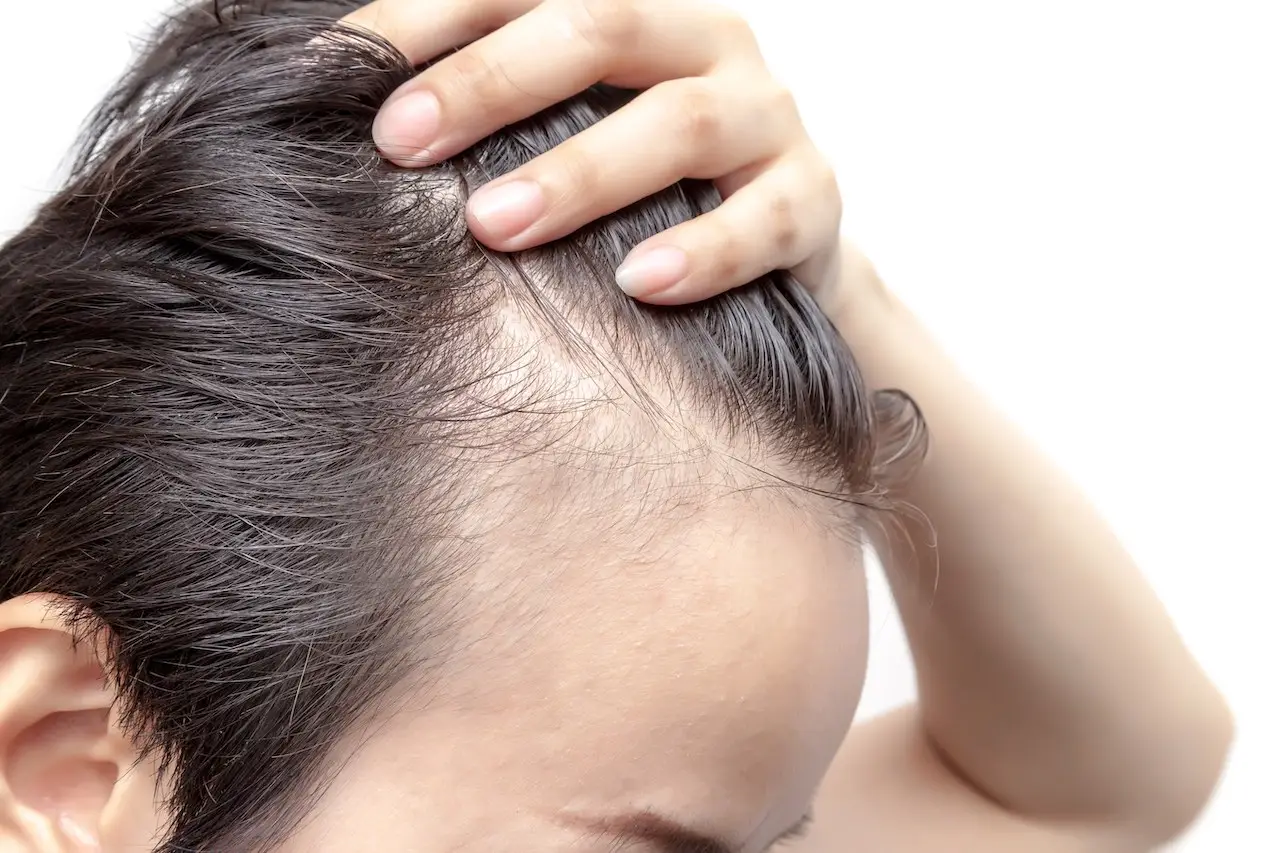

Diagnosing alopecia
The diagnosis of alopecia involves several stages:
Initial consultation
During the initial consultation, our team of experts will perform a complete evaluation of your medical history and discuss your specific hair loss symptoms.
Scalp examination
A thorough scalp examination will be performed to assess the condition of hair follicles, the presence of patches or scars, and the extent of hair loss.
Medical tests
Medical tests, such as blood tests, may be recommended to assess hormonal imbalances or other health problems contributing to alopecia.
Treatments for alopecia
There are many effective treatments for alopecia:
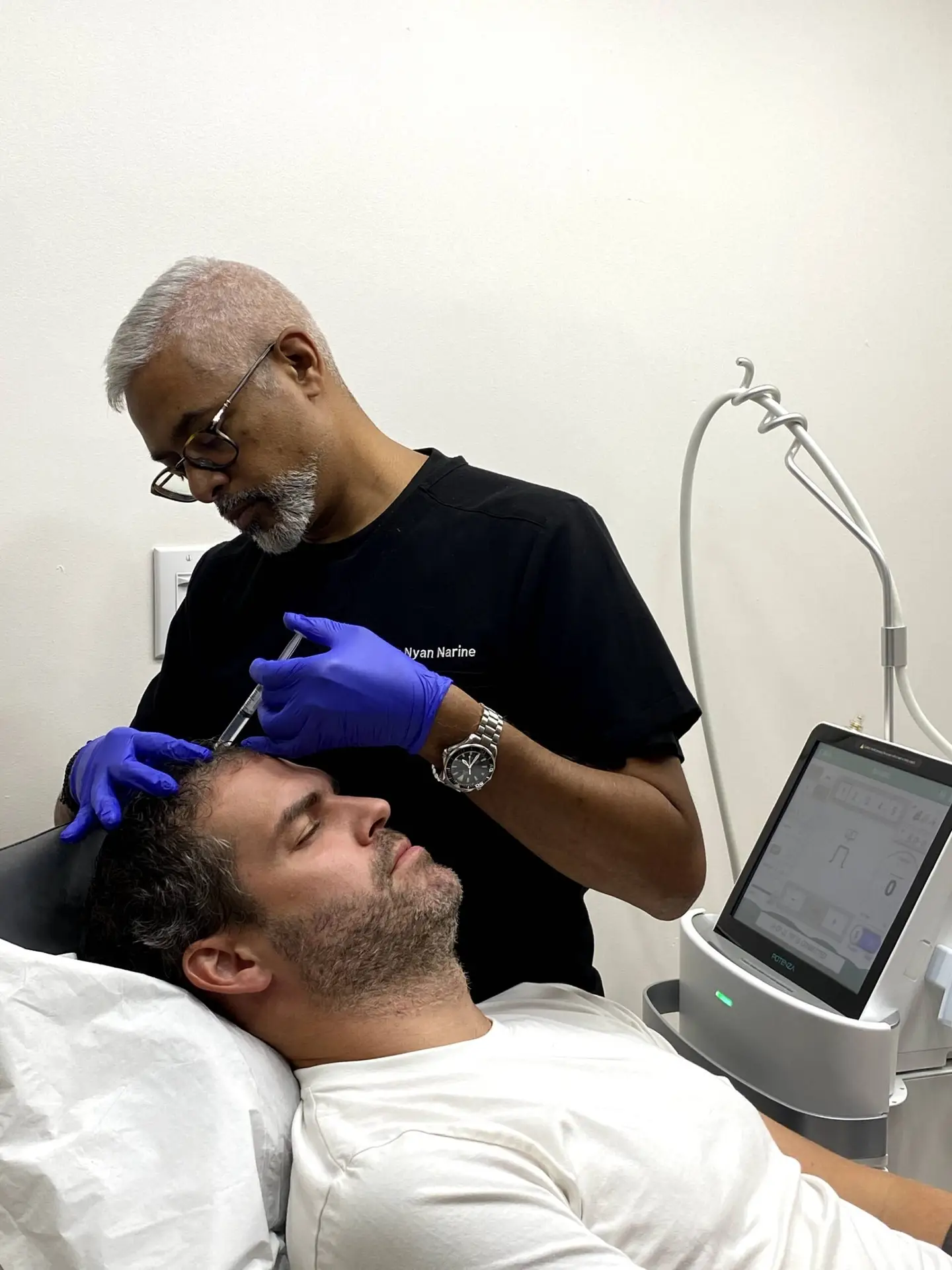
Free consultation
Exosome Treatment for Hair regrowth
Non-human exosomes provide a natural approach to stimulating hair regrowth and improving hair health. Used to regenerate tissues and repair cells, they strengthen hair structure, promoting healthier, more resilient hair.
Platelet-rich plasma (PRP) treatment
PRP treatments use the patient’s platelet-rich plasma to stimulate hair growth. This technique promotes the regeneration of hair follicles.
Hair transplantation
Hair transplantation is an advanced technique that involves removing healthy hair follicles from a donor area and implanting them in balding areas of the scalp.
Medicated treatments
Certain medications, such as minoxidil or finasteride, can be prescribed to slow hair loss and promote regrowth.
LED light therapy
LED light therapies use diodes emitting low-intensity light to stimulate hair follicles and promote hair growth.
Alopecia FAQs
Seasonal changes can increase the risk of seasonal alopecia. For example, in spring, melatonin production decreases, which can make hair more fragile.
The sun can impact hair loss, making it more fragile and brittle. UV rays can also damage the scalp and hair follicles, leading to hair loss.
Hormonal disorders can have an impact on hair loss because they can affect the production of certain hormones that are important for hair growth. For example, androgenetic alopecia is caused by increased sensitivity of hair follicles to the male sex hormone dihydrotestosterone (DHT).
Psychological causes can have an impact on alopecia, as stress, depression and anxiety can disrupt the hair growth cycle and lead to hair loss.
Trichotillomania is a compulsive disorder characterized by compulsive hair-pulling, which can lead to alopecia.
Deficiencies in nutrients such as iron, zinc and vitamins can affect hair growth and lead to hair loss.
Regular hair maintenance can help prevent alopecia. This can include gentle hair care, such as regular brushing, washing with mild products and using nourishing hair care products.
To avoid alopecia, we recommend avoiding aggressive hair practices, such as tight hairstyles, chemical treatments and excessive heat.
Some medical treatments, such as chemotherapy, can lead to hair loss. However, there are also medical treatments that can help treat alopecia, such as topical and oral medications, corticosteroid injections and light therapy.
Pregnancy can increase the risk of alopecia, as hormonal changes can affect the hair growth cycle. However, hair loss due to pregnancy is generally temporary, and hair grows back after delivery.
There are also exceptional causes of alopecia, such as autoimmune diseases, scalp infections and physical trauma.
Your transformation starts here
Do not hesitate to contact us for a personalized consultation and to begin your transformation.
* Results may vary from person to person. We present, to the best of our knowledge, an average of the results obtained. No guarantee is offered. Our goal is to properly evaluate your profile so that you can make an informed decision.
Get a free consultation*
Consultation without obligation
Thousands of satisfied clients have trusted our medical-aesthetic clinic for over 15 years.
Thousands of satisfied customers

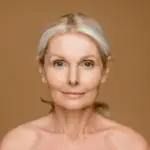


A trusted medical-aesthetic clinic for over 15 years.
⭐️⭐️⭐️⭐️⭐️ — 4.9/5 on Google
Our commitment
Response within 24 hours
Personalized treatment
Contact Us
Phone
(438) 601-4718
Our Address
233 Av. Dunbar, Mont-Royal, QC H3P 2H4, Canada


